
Welcome to

| Home | Photos | Guestbook |
| Newsletter | Links | Contact |
**This web site is published by a private individual
and does not represent the official views of the Peace Corps or the U.S.
government.
What are we doing?
We are proud members of Peace Corps Group #115 – the 115th group of volunteers
to come to Thailand since 1963. The “115ers”consists of a wonderful collection
of 23 people. The average age is about 30 years old. The oldest is 59 and the
youngest is 24. There are 11 men, 12 women, including three couples. Our group
comes from all over the United States with three total from Colorado. Our
backgrounds are diverse, including two attorneys, a research scientist, a stock
broker, a yoga instructor, an engineer, two real estate developers and others
with backgrounds in non-profit, government, social work, business, academics and
who knows what else.
Today we all live in northeast Thailand and depend on each other for friendship
and support as we stumble our way through Thai culture and language. Currently
in Thailand there are approximately 90 volunteers, who have been here anywhere
from 3 months to three years. We have had the opportunity to meet some of them,
but volunteers are spread out in every corner of the country from the beach to
the mountains and speak anything from central Thai to Cambodian and Lao. The
groups before ours in Thailand are all working in the schools. 115 is the first
group under a new program called Community Based Organizational Development (CBOD). Our
supervisor is what we might consider the “mayor” and our co-worker similar to a
city manager. Our goal is to work with small businesses, farmers, and community
groups to help “develop the communities.” How we will undertake this vague, but
honorable objective is still a question. However, right now we are having a heck
of a lot of fun trying to figure it out!
Where are we?
 The region, marked with a
square is known as Isaan and is recognized as the
poorest part of the country. Most of the Thai factory workers in Bangkok or
those who work illegally abroad come from Isaan. The region is dryer than other
part of the country causing agricultural yields to be substantially lower than
elsewhere. A book about the region entitled Isaan: Forgotten Provinces of
Thailand 1996 by Ben Davies, described our area:
The region, marked with a
square is known as Isaan and is recognized as the
poorest part of the country. Most of the Thai factory workers in Bangkok or
those who work illegally abroad come from Isaan. The region is dryer than other
part of the country causing agricultural yields to be substantially lower than
elsewhere. A book about the region entitled Isaan: Forgotten Provinces of
Thailand 1996 by Ben Davies, described our area:
Wherever you travel in Isaan, you will come across tableaus of rural life that
come from another age: families bathing in the river or fishing in the rice
fields. Indeed, whilst Isaan lacks the beaches and colorful hill tribes of
Southern and Northern Thailand, what it offers is far richer and more
meaningful: the struggle of human nature over a largely inhospitable
environment.
We are living in the Province of Buriram.
Our cluster of villages contains about 6,000 people in a radius of about 10
miles. Our immediate area has about 3000 people living in a very rural setting
near banana groves, cassava and rubber plantations and a whole lot of cows and
rice fields. Our village has few paved roads, no phone lines, but extremely warm
and welcoming people. We are about 6 hours from Bangkok by bus. The nearest
grocery market, phone line, or public transportation is a 6 mile bike ride away.
We do have a few tiny stores where we can buy basic necessities like toilet
paper, chips and soda, but not much else.
Our House
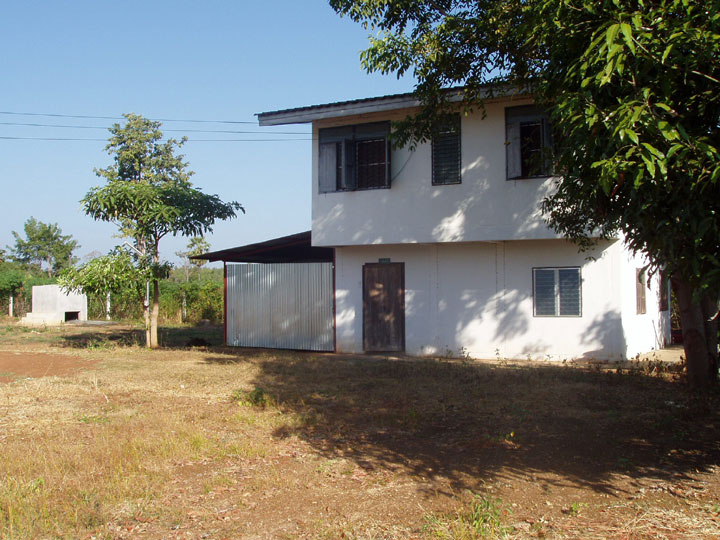 We are thankful to the community for providing us with a very nice house
compared to other potential options. Its biggest asset is the building materials
it is made from. Cinder block will be cool when temperatures hover around 100 F
during the hot season. The house is about 1,000 SF, including two bathrooms, a
balcony and a garage, which we can only use for our bikes. It has electricity
and well water. The house is part of the health center, which is directly in
front. Our location at the health center has a number of advantages including
great neighbors (medically trained), outdoor lighting, a dog owned by the
healthcare workers, and the fact that people come and go from the center every
day for a variety of activities, including evening aerobics.
We are thankful to the community for providing us with a very nice house
compared to other potential options. Its biggest asset is the building materials
it is made from. Cinder block will be cool when temperatures hover around 100 F
during the hot season. The house is about 1,000 SF, including two bathrooms, a
balcony and a garage, which we can only use for our bikes. It has electricity
and well water. The house is part of the health center, which is directly in
front. Our location at the health center has a number of advantages including
great neighbors (medically trained), outdoor lighting, a dog owned by the
healthcare workers, and the fact that people come and go from the center every
day for a variety of activities, including evening aerobics.
Relaxing at home.
 The Poinsettia is our vestige of Christmas. All the floors on
the first floor of our house are cement. We have laid down several grass mats to
try and make it more comfortable. The upstairs floors are all wood. The grass
mats all over the house were had woven by villagers.
The Poinsettia is our vestige of Christmas. All the floors on
the first floor of our house are cement. We have laid down several grass mats to
try and make it more comfortable. The upstairs floors are all wood. The grass
mats all over the house were had woven by villagers.

 View
of our neighbor off the back
balcony. This is a farmer’s house in the
middle of a large cassava field. We did not know about Cassava until we got
here. Apparently, you can make oil out of it and eat the roots after cooking.
Behind is all rice fields. Most the fields are brown right because they have
been completely harvested. May of trees in the background are rubber trees.
View
of our neighbor off the back
balcony. This is a farmer’s house in the
middle of a large cassava field. We did not know about Cassava until we got
here. Apparently, you can make oil out of it and eat the roots after cooking.
Behind is all rice fields. Most the fields are brown right because they have
been completely harvested. May of trees in the background are rubber trees.
The house is relatively empty except for two fold up chairs, a small fridge, a
washing machine, several grass mats, a fan and a mattress for two. We are living
pretty close to the same standard of living as most of our neighbors. Peace
Corps provides a modest move-in allowance, but couples are lucky to get double.
Therefore, we decided to use our extra dough to splurge on a washing machine.
Having washed our clothes several times by hand during the last few months
(which takes a LONG time when we wear many clothes during the day because we
sweat so much), we decided that we would rather spend our weekends doing things
other than laundry!
When entering a Thai house, the first thing that struck most of the volunteers
was the lack of, well, stuff. From our observations it appears Thai villagers
really don’t have much furniture at all. Typically you sit on the floor for
everything, which has given us a new concept of flexibility. The few pieces of
furniture are usually a beautifully wood-carve bench and a large box for
clothing. We more-or-less have the same setup, except for two cheesy fold –up
chairs in place of an artistically carved wood bench, that is typically carved
from the large roots of a tree.
The house has no kitchen. It seems a lot of Thai villagers typically cook and/
or wash dishes outside. We haven’t seen many sinks, either in the kitchen or the
bathroom. Therefore, we wash our dishes in large buckets. We have a water facet
on the “back patio” that serves as our kitchen. The bathrooms are perhaps most
interesting. They are nearly always wet. So wearing socks of any sort is a
mistake. Most toilets are squat and flushing consists of scooping water from a
basin and pouring it into the toilet. Showering involves scooping water out of a
different basin and pouring it over your head while standing in the middle of
the bathroom. There is no designated place to pour the water and that is why if
you enter the bathroom your feet will get wet just about every time unless no
one has used it in a while.
dishes outside. We haven’t seen many sinks, either in the kitchen or the
bathroom. Therefore, we wash our dishes in large buckets. We have a water facet
on the “back patio” that serves as our kitchen. The bathrooms are perhaps most
interesting. They are nearly always wet. So wearing socks of any sort is a
mistake. Most toilets are squat and flushing consists of scooping water from a
basin and pouring it into the toilet. Showering involves scooping water out of a
different basin and pouring it over your head while standing in the middle of
the bathroom. There is no designated place to pour the water and that is why if
you enter the bathroom your feet will get wet just about every time unless no
one has used it in a while.
What we do not have that nearly every Thai owns is a low, large table often
covered with a thatched roof. It is positioned strategically, outside at the
front of the house where any friend that walks by must inevitably join you for
an Indian style squat. We like to call it the “hangout table.” Most families
appear to spend considerable time sitting on these tables talking, eating, and
just hanging out like Thai’s do. It is the proverbial kitchen table and more.
Literally, everything happens on and around them. So far in Thailand, we have
probably already logged 100’s our hours eating meals and talking to people on
these tables. It has the best atmosphere of any place in the Thai home. In terms
of concepts from the United States, just think of what takes place at the
kitchen table, living room (subtract the TV) then add the local pub, your job
(i.e. weaving silk), and your work bench in the garage. While each of these
places are different in the American household, they are all located at and
around the Thai “hangout table.” However, we don’t plan to build one at our new
house. If we are doing our job right, we will continue to spend most of our time
at other people’s tables.
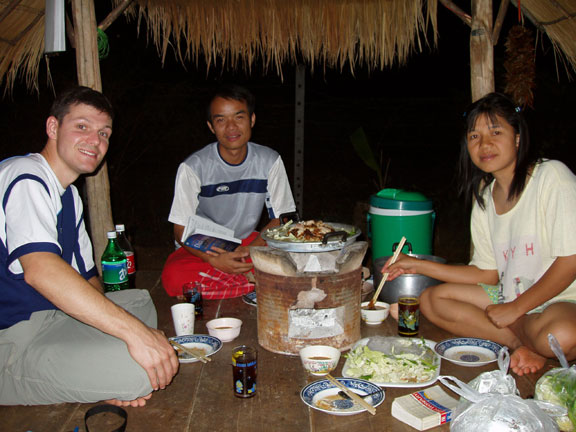
Here is a picture of Cullen and our neighbors Dang and Ning on their table. We are eating one of the specialty BBQ dishes that involves
grilling your pork and vegetables as you eat it.
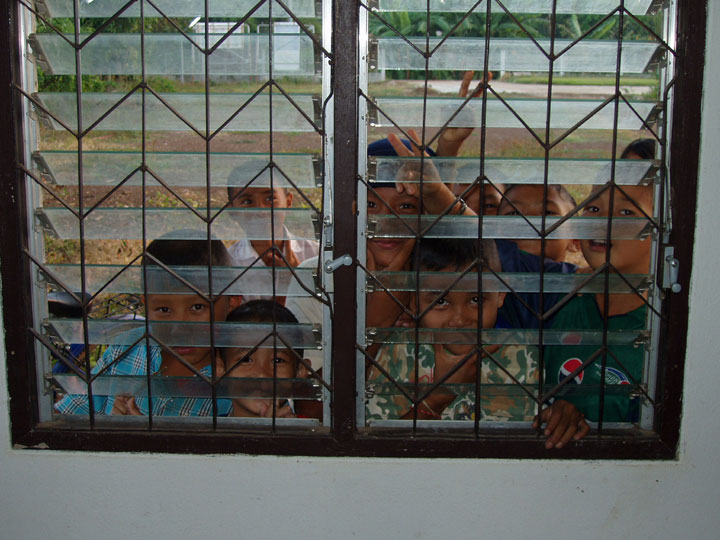
When we first moved into our house, we had kids watching our every move for the
first few weeks. We couldn’t resist taking a picture of one of the windows.
Work Life and a Routine?
Work? Or just “experiencing?”
Right now our job is to learn Thai and be sponges! Absorb everything - from the
aroma of the rice on our plates that was just harvested, to the sound of morning
announcements over the village loud speaker at 5:45 AM, to the astoundingly warm
smiles we get from everyone when we ride by on our Peace Corps issued bikes. The
three goals of the Peace Corps are the following: 1) Help people meet their
needs for trained men and women; 2) Promote a better understanding of America on
the part of the peoples served; 3) Promote a better understanding of other
peoples on the part of Americans. So, far we have unquestionably worked very
hard on goals 2 and 3. How we achieve #1 is the hard part. The needs are
definitely here. We see, work and play with people everyday that, without
question, live in poverty. Right now we are focused on trying to learn the
language, culture and community enough to hopefully do something that helps.
We’ll keep you updated on how that goes, and perhaps will ask you to help us
from your end.
So, here is a snap shot of our typical day (at least the last few weeks). I add
the caveat because life here is fantastically unpredictable. We are really
having a lot of fun - kind of like going to the amusement park for the first
time. You never know what you’ll find around the next corner. One of our
trainers once said that everyday will be an epic. Well, she was right. But what
she left out was the fact that each epic would be entirely unexpected, unplanned
and new. We never know what will happen each day. I can’t tell you how often we
are invited to go someplace to do something, then it turns out to be something
entirely different.
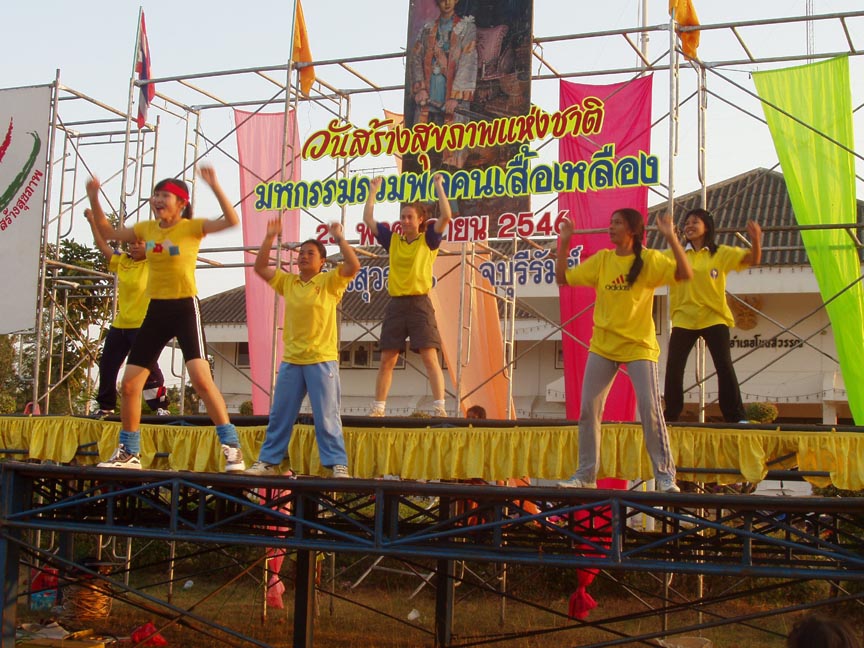 A few examples include, Vanessa’s dancing aerobics in front
of 1,000’s of people on national exercise day (instead of participating like
everyone else); Cullen serving as the leader of a village parade when he thought
he was going to play in a soccer game; showing up at someone’s house to learn
about bio-fertilizer production and ending up harvesting rice by hand in a rice
field, and receiving two 10 foot long anaconda snakes as house warming gifts
after apparently giving someone the wrong impression about “our strong
appreciation of snakes.”
A few examples include, Vanessa’s dancing aerobics in front
of 1,000’s of people on national exercise day (instead of participating like
everyone else); Cullen serving as the leader of a village parade when he thought
he was going to play in a soccer game; showing up at someone’s house to learn
about bio-fertilizer production and ending up harvesting rice by hand in a rice
field, and receiving two 10 foot long anaconda snakes as house warming gifts
after apparently giving someone the wrong impression about “our strong
appreciation of snakes.”
Picture of Vanessa on stage for national aerobics day. There were probably over
1,500 people in front of the stage. Cullen was glad not to get recruited at the
last minute to join the his glamorous “model” wife on stage.
Anyway, back to the “typical day:” We awake to the sounds of either morning
announcements or cock-a-doodle-dooo. There are hundreds of chickens in our
village and the cocks around our house don’t like us to sleep in. However, this
week it was the booming sounds of a “funeral.” Apparently when someone dies you
have several days of what sound like a “party”?!?!?!? The Thai rock and/or
karaoke over the loud speaker started at 5 AM on Monday and continued for the
next three days and nights. Now, you know as much as we do about Thai funerals.
We often start running around 6:30 on the dirt roads through the rice fields,
which is a beautiful setting. We run by rice, cows, farmers, cassava plants,
rubber plantations, banana trees, sugar cane and Chili pepper plants. Once back
at the house we heat up some water in the hot pot to dump into the water basin.
Believe it or not mornings are actually pretty chilly right now. Therefore, the
water in the basin can be shockingly cold. During breakfast we drink our cup of
Nescafe often listening to the BBC World Service or Voice of America when
reception is good enough. We mostly cook breakfast at home, which may often
consist of the peanut butter and jelly we bought in Bangkok or banana muffins if
we were fortunate enough that week get a ride to the district town market.
Sometimes we go to our favorite restaurant, which consists of four tables and
one cook.
Then we head off to work. Where is work you may wonder? Well, it depends on the
day based on a monthly schedule the villagers and city manager worked out with
us. In general, we are spending these first few months learning about the
community. Therefore, we spend each day at a different place doing different
things. The places include: the city administrative offices (see picture with
cows in front), the pre-, elementary, and high schools, the banana snack makers,
the silk weavers, the organic fertilizer makers, the rice farmers, the mushroom
farmers, or the health center. Activities have included: teaching anything from
English to computers, refereeing children soccer games, running the
mini-marathon with the elementary school kids, helping to feed the pre-school
children lunch, eating silk warms, searching the internet for grants for a
school chicken project, drinking beer and whisky, harvesting rice or just
talking.
As mentioned before, each day is unpredictable. However, the one thing that we
can count on is spending each and every day simply talking to people. We discuss
anything and everything from how they make a living, to how Americans can
survive without eating rice every meal of everyday. Well, let us use a different
word. We communicate. We communicate through our poor Thai pronunciation,
dictionary look ups, hand signals, charades as well as a variety of animal
sounds, imitations and/or a series of grunts. In fact, we are often amazed how
much we can understand and convey. Amazed at both the breadth and depth as well
as the lack of basic communication given the person and topic. There is one
other thing that is consistent in our days: without exception, people want to
feed us. We can count on eating and drinking things that are delicious,
disgusting, known, unknown, alcoholic, non-alcoholic or just weird. And
sometimes its hard when we know that some of their kids, who lack adequate
protein in their diet, would gladly eat the pig ear or eel that we are politely
trying to cover up on our plate.
Typically, the work day ends between 4 and 5PM and we are often pretty tired.
Mostly from speaking Thai, but sometimes from riding our bikes the 10-14 miles
to and from either the farthest cluster of villages or the district town. Yet,
do we stop? Heck no! Next we either, do aerobics at the health center (started
this week), get invited to someone’s house for dinner, make dinner at our house
or eat with our neighbors on their thatched roof table. This gets us home about
9PM to fall into bed and start all over again tomorrow.
Thai Food
As we have mentioned in our previous emails, we feel very fortunate to have a
small restaurant in our town which luckily opened just before our arrival. We
were really shocked when the proprietor showed off her English menu. We later
learned that it was a menu she got from a restaurant in the tourist part of
southern Thailand and we were the first foreigners to ever see it. But what the
heck, she has been able to make just about everything listed on it so far. In
general, Thai food is very good. The variety is both broad yet narrow. Broad
because there is a wonderful variety of curries, fish, pork and chicken dishes,
as well as, a crazy array of deserts. Yet, narrow because every meal contains
rice (or rice noodles) and fish sauce. In fact the word for eat is literally
“eat rice.” You do not say: have you eaten yet, which could be misunderstood as
“have you drank yet.” Rather you typically say “have you eaten rice yet.” In
fact, 90% of the crazy array of desserts are made from rice. There are a few
weird things that we have eaten recently, which we have listed in previous
e-mails like raw pork, eel, pig ear, silk warms, blood, insects, but in general
we have enjoyed the food very much. However, one thing has made eating
challenging, and that has been the amount of chili peppers contained in many
Thai dishes. Cullen used to enjoy the “Hot” versions of Pace Picante and Tobasco
Sauces. But, as one of our trainers once said, the Thais often eat “rip your
head off spicy hot food.” Man, we mean spicy stuff. To give you an idea. We
enjoy a papaya salad called Som Tom. After these three months, Vanessa can eat
this dish with 1-2 chili’s in it. Cullen can eat it with 4-5 chili’s. Meanwhile,
most Thai’s eat this delicious dish with 10 or more chili’s!
One interesting experience we have had with food has been trying to share our
American dishes with our new friends. First, imagine trying to determine what to
cook when basics like cheese, bread, spices are not available. Second, very few
people have ever eaten things like pasta, hamburgers or pizza. In fact, we
haven’t found a neighbor yet who has ever heard of McDonalds. Therefore, we
should have known that our attempts to share American dishes would ultimately
end poorly. Since a lot of western food is available in Bangkok, we tried to
find as many items as we could to bring back to share. Therefore, were able to
introduce, cheese, olives, peanut butter, spaghetti, macaroni & cheese and
pancakes. These items resulted in 5 strikes and 1 home run. The response from
spaghetti and peanut butter was luke warm at best. The attempt at macaroni
resulted in a few polite tastes of two – three macaroni’s per person. The olives
and Gouda cheese resulted in the worst response by far. Thai’s are known for
being extraordinarily polite. But no rules of cultural conduct could stop one of
our friends from spitting a piece of cheese out of her mouth after the first
taste. So, what keeps us from completely destroying the culinary reputation of
America among our Thai villagers? Banana Pancakes and syrup saved the day! They
loved it and may actually come back to try something else if we can find other
western foods to bring back.
Kids
Kids have become a big part of our experience here. We see them at school, on
the streets and, as we described in a past e-mail, they used to hang out at our
house and watch us through the windows during our first few weeks here.
Sometimes they still come by to watch - just to see if we are doing anything
different from their last visit. I think they come whenever they get bored. This
week they watched us do our laundry. Many of them are poor. We haven’t
figured out percentages yet, but we know that many of their parents do not live
here for a good part of the year. One or both of the parents live in Bangkok or
aboard in places like Korea, Taiwan and Hong Kong. It sounds like many, if not
most, work illegally in these countries. Those who work in Bangkok come home at
least two times during the year – rice harvesting time or New Years. Rice
harvesting lasts three months and consists of cutting rice stalks by hand seven
days a week. We joined a farmer one day and it gets pretty hot under the sun all
day. Then the Thai /Buddhist New Year is in April. We understand that those
working abroad mostly stay for 3 – 5 years. Some supposedly stay even longer and
during this time the kids live with the grandparents. The grandparents and the
kids eat the rice all year that the parents harvest. They buy meat with the
money that the parents send home. Unfortunately, we have been told by our
friends at the health center and the schools that may of the kids don’t receive
adequate protein since many of the meals eaten by the kids are only rice, which
lack the protein they need. We have noticed some of the kids in school are
smaller than the others, have less energy and are not very attentive. We assume
they are malnourished.
In general they are unbelievably well behaved. As a result you can’t help but
fall in love with them. In the school, it appears common for the teachers to
leave the kids alone in the rooms from 10 minutes, to all day depending on what
other things they need to do that day. The kids seem to be used to this and stay
in the class and just hang out without causing a disturbance or running wild.
They seem to listen to authority attentively. When you tell them to do
something, they will always do it.
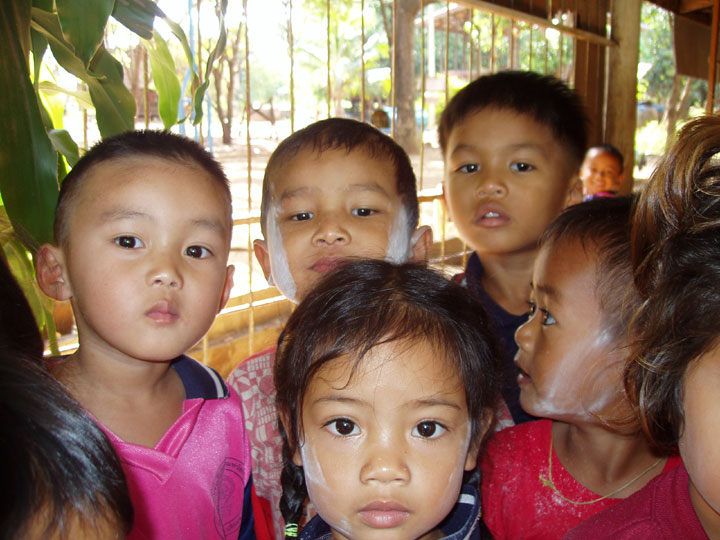 Here are a few kids in the pre-school. The Thais put powder on the kids to help
keep them cool. Note the US Army shirt on the kid at right. Oddly, are a lot of
cloths with English written on them. US Army seems like a frequent thing.
Sometimes there are obscene words on the shirts, but they are misspelled. I once
saw one that said “Fuke you”.
Here are a few kids in the pre-school. The Thais put powder on the kids to help
keep them cool. Note the US Army shirt on the kid at right. Oddly, are a lot of
cloths with English written on them. US Army seems like a frequent thing.
Sometimes there are obscene words on the shirts, but they are misspelled. I once
saw one that said “Fuke you”.
We have had a few unique experiences and that makes us think about these sweet
kids a lot. One recent experience was the “mini-marathon.” Two weeks ago the
school sponsored Sport Week that included soccer, volley ball, running etc. We
arranged our schedule so that we could help out every day. The mini- marathon
started about 4 miles from the school. We went out there in 4 pick up trucks
that, somehow, held about 100 kids. Vanessa and I just started running again and
were glad to run with the kids. We were the only “teachers” to actually run,
while the others road bikes or drove the pick ups. The road alternated between
rough pavement filled with pot holes to gravel. After the first mile or so the
kids started to walk a lot. Then one of the kids said her feet hurt. It was then
that I realized nearly all of these kids were without shoes! We have become so
used to seeing these kids barefoot all of the time that it never occurred to us
that these poor kids were running this mini-marathon without shoes. Nearly all
have flip-flops. Some are new, some worn down to paper thinness and others wear
different colors and sizes- one flip flop on each foot from different pairs that
lost their mates long ago. During the run the kids alternated between wearing
flip flops and not wearing them. After this poor little child told me her feet
hurt, our little fun run turned into a torturous nightmare for me. As I walked
and ran these horrible four miles in my $100 running New Balance shoes from REI,
my mind was reeling. How can these kids run on this pavement, on these rocks and
gravel, … not to mention through the broken glass on the road? How could these
teachers organize an event that could hurt these kids? My heart moved in and out
of sympathy and admiration for these bold little mini-marathon runners as we ran
and walked through one grueling mile marker to the next. All the way, I watched
the kids with flip flops alternate between wearing their flip flops on their
feet to holding them in their hands. I guess after a while the strap between
their toes hurt just as much as the pavement did.
Fortunately the run soon ended at the school about 8AM. The schedule for the day
contained a number of other sports for the kids to participate in. Their
enthusiasm seemed to far out weigh the pain that the blisters may have caused.
We watched the same kids play soccer without shoes. Some had problems. One 8th
grader in particular wrapped her blistered feet in bandages. But she seemed to
play soccer and volleyball that day as hard as any of the other kids. Since most
of the kids have never really worn shoes we figured that the calluses on their
feet must be super tough anyway. Plus the fact that there are very few
opportunities for organized sports, especially for girls, the kids absolutely
loved the event.
Weather
Right now we are in the cold season, which lasts until February or March. Then,
we have been told, the hot season will last 3 – 5 months, followed by the rainy
season. The cold season is very pleasant. When we wake up in the mornings our
thermometer says that it is about 68 degrees F. Then the mercury climbs
throughout the day to about 85 or 90 degrees. Oddly our bodies are adjusting to
that of the Thai’s. When we first arrived here we used to laugh at how the Thais
wear jackets when it the temperature was at a frigid 75 degrees. Well, believe
it or not we are starting to pull out our sweatshirts at about 72 degrees. In
fact, every night we sleep under a blanket because it is down right cold. Last
night, I actually slept in a sweatshirt for the first time. I had to look at the
thermometer when I wake up and had to laugh because is read a chili 68 degrees
F. Maybe it’s the food or the high humidity, but believe it or not 68 degrees
feels pretty cold right now.
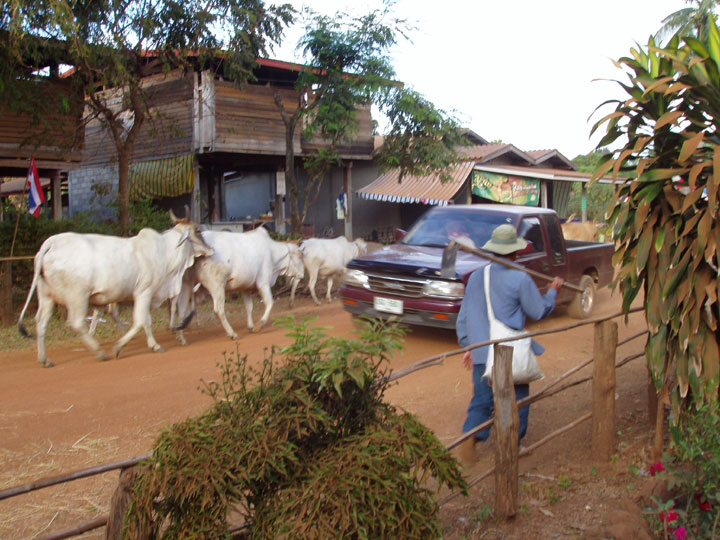
Rush hour in the village. Cows are a frequent sight in the streets of the village. We have become accustomed to riding our bikes through small herds walking through the streets. The gentleman on the right is the herder.
 Typical view down one of the streets in the village. Since none of the streets
of the village have names, we have started naming them ourselves. This is Silk
Street since there are a lot of silk weavers here. We have also named others
streets, Mangy Dog Street, Main Street, Home Street and National Geographic
Street. The last street got its name because it has a lot of trees with a large
number of houses on stilts. It looks like a picture out of National Geographic.
Typical view down one of the streets in the village. Since none of the streets
of the village have names, we have started naming them ourselves. This is Silk
Street since there are a lot of silk weavers here. We have also named others
streets, Mangy Dog Street, Main Street, Home Street and National Geographic
Street. The last street got its name because it has a lot of trees with a large
number of houses on stilts. It looks like a picture out of National Geographic.